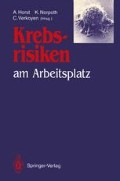Zusammenfassung
Die Erkennung für den Menschen krebsgefährdender Stoffe bereitet grundsätzliche methodische Schwierigkeiten.
Access this chapter
Tax calculation will be finalised at checkout
Purchases are for personal use only
Preview
Unable to display preview. Download preview PDF.
Literatur
Ames BN, Gold SL (1990a) Chemical carcinogenesis: too many rodent carcinogenes. Proc Natl Acad Sci USA 87:7772–7776
Ames BN, Profet M, Gold SL (1990b) Dietary pesticides (99.99% all natural). Proc Natl Acad Sci USA 87:7777–7781
Arnes BN, Profet M, Gold SL (1990c) Nature’s chemicals and synthetic chemicals: comparative toxicology. Proc Natl Acad Sci USA 87:7782–7786
Bermudez E, Mirsalis JC, Eales HC (1982) Detection of DNA damage in primary cultures of rat hepatocytes following in vivo and in vitro exposure to genotoxic agents. Environ Mutagen 4:667–670
Bolm-Audorff U, Spiegelhalder B, Bienfait H-G, Preussmann R (1989) Häufigkeit ni-trosaminhaltiger Kühlschmiermittel in der Metallindustrie. In: Jansen G (Hrsg) Verhandlungen der Deutschen Gesellschft für Arbeitsmedizin. Stuttgart
Bridges BA (1988) Genetic toxicology at the crossroads — a personal view on the deployment of short-term tests for predicting carcinogenicity. Mutat Res 205:25–31
Daniel FB, Schut HAJ, Sandwisch DW, Schenk KM, Hoffmann CO, Patrick JR, Stoner GD (1983) Interspecies comparisons of benzo(a)pyrene metabolism and DNA adduct formation in cultured human and animal bladder and tracheobronchial tissues. Cancer Res 43:4723–4729
Denkel E, Pool BL, Schlehofer JR, Eisenbrand G (1986) Biological activity of N-nitrosodiethanolamine and of potential metabolites which may arise after activation by alcohol dehydrogenase in Salmonella typhimurium, in mammalian cells, and in vivo. J Cancer Res Clin Oncol 111:149–153
Dittberner U, Eisenbrand G, Zankl H (1988) Cytogenetic effects of N-nitrosodiethanolamine (NDELA) and NDELA-monoacetate in human lymphocytes. J Cancer Res Clin Oncol 114:575–578
Doerjer G, Buchholz U, Kreutzer K, Oesch F (1988) Biomonitoring of DNA damage by alkaline filter elution. Int Arch Occup Health 60:169–174
Ehrenberg L, Hiesche KD, Ostermann-Golkar S, Wennberg I (1983) Evaluation of genetic risk of alkylating agents: tissue dose in the mouse from air contaminated with ethylene oxide. Mutat Res 24:83–103
Eisenbrand G, Denkel E, Pool BL (1984) Alcoholdehydrogenase as an activating enzyme for N-nitrosodiethanolamine (NDELA): in vitro activation of NDELA to a potent mutagen in Salmonella typhimurium. J Cancer Res Clin Oncol 108:76–80
Fan TY, Morrison J, Rounbehler DP, Ross R, Fine DH (1977) N-Nitrosodiethanolamine in synthetic cutting fluids: a part per hundred impurity. Science 196:70–71
Fuchs J, Burg J, Bienfait H-G, Hiltl G, Bolm-Audorff U (1991) Monotoring the effects of the occupational exposure of metal workers. Naunyn-Schmiedeberg’s Arch Pharmacol 343 [Suppl]: 32
Hecht SS, Lijinsky W, Kovatch RM, Chung FL, Saavedra JE (1989) Comparative tu-morigenicity of N-nitroso-2-hydroxy-morpholine, N-nitrosodiethanolamine and N-ni-trosomorpholine in A/J mice and F344 rats. Carcinogenesis 10:1475–1477
Hengstler JG (1991a) Alkalische Elution mononukleärer Zellen von Patienten mit zyto-statischer Therapie, Rauchern und Nichtrauchern sowie Nachweis von DNA-Strangbrüchen in Zellkultursystemen. Dissertation, Mainz
Hengstler JG, Fuchs J, Oesch F (1991b) DNA strand breaks caused by chemotherapy with alkylating agents in humans. J Cancer Res Clin Oncol 117 [Suppl]:41
Kohn KW, Ewing RAG, Erickson LC, Zwelling LA (1980) Measurement of strand breaks and cross-links by alkaline elution. In: Friedberg EC, Hanawalt PC (eds) DNA repair. New York, pp 379–401
Larsen KH, Brash D, Cleaver JE, Hart RW, Maher VM, Painter RB, Sega GA (1982) DNA repair assays as tests for environmental mutagens. A report of the U.S. EPA Gene-tox Program. Mutat Res 98:287–318
Lijinsky W, Kovatch RM (1985) Induction of liver tumors by nitrosodiethanolamine at low doses. Carcinogenesis 6:1679–1681
Nakayama T, Kaneko M, Kodama M (1985) Cigarette smoke induces DNA single-strand breaks in human cells. Nature 314:462–464
Oesch F, Aulmann W, Platt KL, Doerjer G (1987) Individual differences in DNA repair capacities in man. Arch Toxicol [Suppl] 10:172–179
Parodi S, Taningher M, Santi L (1988) Utilization of the quantitative component of positive and negative results of short-terms tests. Mutat Res 205:283–294
Preussmann R, Habs M, Habs H, Schmähl D (1982) Carcinogenicity of N-nitrosodiethanolamine in rats at five different dose levels. Cancer Res 42:5167–5171
Schut HAJ, Daniel FB, Schenk KM, Loeb TR, Stoner GD (1984) Metabolism and DNA adduct formation of 2-acetylamino-fluorene by bladder expiants from human, dog, monkey, hamster and rat. Carcinogenesis 5:1287–1292
Sina JF, Bean CL, Dysart GR, Taylor VI, Bradley MO (1983) Evaluation of the alkaline elution/rat hepatocyte assay as a predictor of carcinogenic/mutagenic potential. Mutat Res 113:357–391
Skare JA, Schrotel KR (1985) Validation of an in vivo alkaline elution assay to detect DNA damage in rat testicular cells. Environ Mutagen 7:563–576
Sterzel W, Eisenbrand G (1986) N-Nitrosodiethanolamine is activated in the rat to an ultimate genotoxic metabolite by sulfotransferase. J Cancer Res Clin Oncol 111:20–24
Editor information
Editors and Affiliations
Rights and permissions
Copyright information
© 1992 Springer-Verlag Berlin Heidelberg
About this paper
Cite this paper
Fuchs, J., Oesch, F. (1992). Die Verwendung der alkalischen Filterelution zur Detektion genschädigender Belastungen am Arbeitsplatz. In: Horst, A., Norpoth, K., Verkoyen, C. (eds) Krebsrisiken am Arbeitsplatz. Springer, Berlin, Heidelberg. https://doi.org/10.1007/978-3-642-77128-6_13
Download citation
DOI: https://doi.org/10.1007/978-3-642-77128-6_13
Publisher Name: Springer, Berlin, Heidelberg
Print ISBN: 978-3-540-54862-1
Online ISBN: 978-3-642-77128-6
eBook Packages: Springer Book Archive

